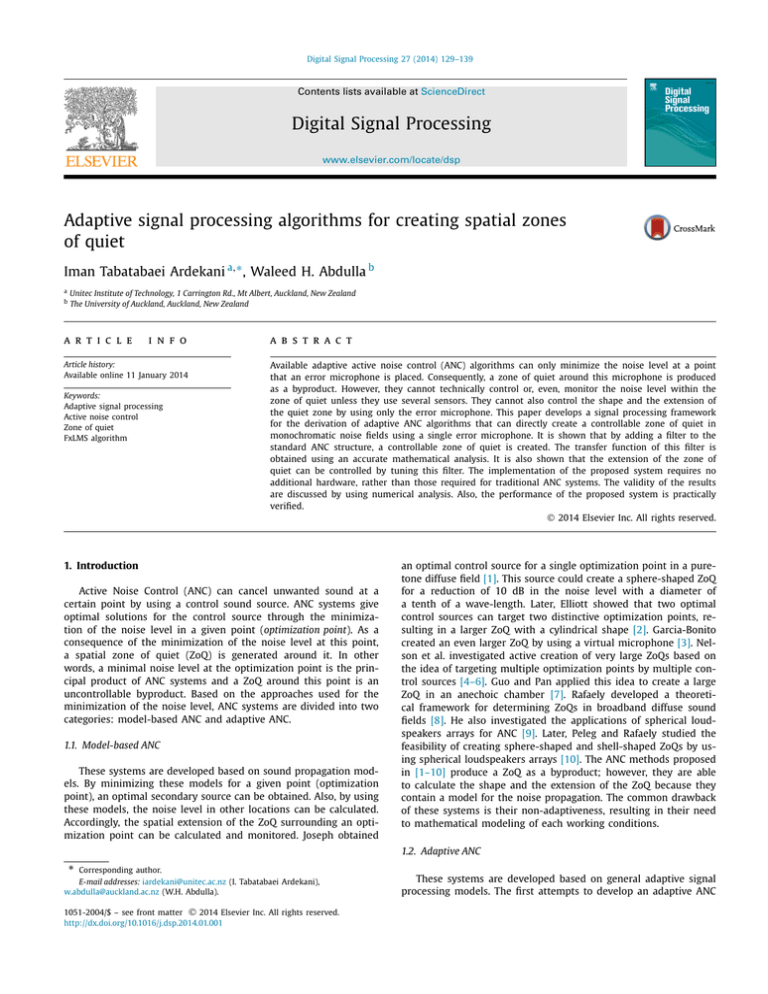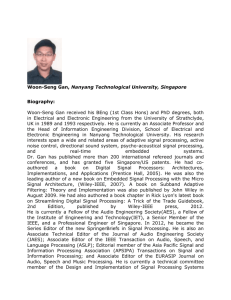Preview Free (First 2 Pages PDF)
advertisement

Digital Signal Processing 27 (2014) 129–139 Contents lists available at ScienceDirect Digital Signal Processing www.elsevier.com/locate/dsp Adaptive signal processing algorithms for creating spatial zones of quiet Iman Tabatabaei Ardekani a,∗ , Waleed H. Abdulla b a b Unitec Institute of Technology, 1 Carrington Rd., Mt Albert, Auckland, New Zealand The University of Auckland, Auckland, New Zealand a r t i c l e i n f o Article history: Available online 11 January 2014 Keywords: Adaptive signal processing Active noise control Zone of quiet FxLMS algorithm a b s t r a c t Available adaptive active noise control (ANC) algorithms can only minimize the noise level at a point that an error microphone is placed. Consequently, a zone of quiet around this microphone is produced as a byproduct. However, they cannot technically control or, even, monitor the noise level within the zone of quiet unless they use several sensors. They cannot also control the shape and the extension of the quiet zone by using only the error microphone. This paper develops a signal processing framework for the derivation of adaptive ANC algorithms that can directly create a controllable zone of quiet in monochromatic noise fields using a single error microphone. It is shown that by adding a filter to the standard ANC structure, a controllable zone of quiet is created. The transfer function of this filter is obtained using an accurate mathematical analysis. It is also shown that the extension of the zone of quiet can be controlled by tuning this filter. The implementation of the proposed system requires no additional hardware, rather than those required for traditional ANC systems. The validity of the results are discussed by using numerical analysis. Also, the performance of the proposed system is practically verified. © 2014 Elsevier Inc. All rights reserved. 1. Introduction Active Noise Control (ANC) can cancel unwanted sound at a certain point by using a control sound source. ANC systems give optimal solutions for the control source through the minimization of the noise level in a given point (optimization point). As a consequence of the minimization of the noise level at this point, a spatial zone of quiet (ZoQ) is generated around it. In other words, a minimal noise level at the optimization point is the principal product of ANC systems and a ZoQ around this point is an uncontrollable byproduct. Based on the approaches used for the minimization of the noise level, ANC systems are divided into two categories: model-based ANC and adaptive ANC. 1.1. Model-based ANC These systems are developed based on sound propagation models. By minimizing these models for a given point (optimization point), an optimal secondary source can be obtained. Also, by using these models, the noise level in other locations can be calculated. Accordingly, the spatial extension of the ZoQ surrounding an optimization point can be calculated and monitored. Joseph obtained an optimal control source for a single optimization point in a puretone diffuse field [1]. This source could create a sphere-shaped ZoQ for a reduction of 10 dB in the noise level with a diameter of a tenth of a wave-length. Later, Elliott showed that two optimal control sources can target two distinctive optimization points, resulting in a larger ZoQ with a cylindrical shape [2]. Garcia-Bonito created an even larger ZoQ by using a virtual microphone [3]. Nelson et al. investigated active creation of very large ZoQs based on the idea of targeting multiple optimization points by multiple control sources [4–6]. Guo and Pan applied this idea to create a large ZoQ in an anechoic chamber [7]. Rafaely developed a theoretical framework for determining ZoQs in broadband diffuse sound fields [8]. He also investigated the applications of spherical loudspeakers arrays for ANC [9]. Later, Peleg and Rafaely studied the feasibility of creating sphere-shaped and shell-shaped ZoQs by using spherical loudspeakers arrays [10]. The ANC methods proposed in [1–10] produce a ZoQ as a byproduct; however, they are able to calculate the shape and the extension of the ZoQ because they contain a model for the noise propagation. The common drawback of these systems is their non-adaptiveness, resulting in their need to mathematical modeling of each working conditions. 1.2. Adaptive ANC * Corresponding author. E-mail addresses: iardekani@unitec.ac.nz (I. Tabatabaei Ardekani), w.abdulla@auckland.ac.nz (W.H. Abdulla). 1051-2004/$ – see front matter © 2014 Elsevier Inc. All rights reserved. http://dx.doi.org/10.1016/j.dsp.2014.01.001 These systems are developed based on general adaptive signal processing models. The first attempts to develop an adaptive ANC 130 I. Tabatabaei Ardekani, W.H. Abdulla / Digital Signal Processing 27 (2014) 129–139 Table 1 Significant studies on ANC systems (only those with both theoretical and practical contributions). Optimization target Control source adjustment process Non-adaptive Adaptive Discrete points • • • • • • • • • • Spatial zone * # 1994: Joseph et al. [1] 1995: Elliott [2] 1997: Garcia-Bonito et al. [3] 1999: Nelson et al. [4–6] Guo and Pan [7] 2001: Rafaely [8] • 2009: Rafaely [9]* • 2011: Peleg and Rafaely [10]* 1981: Burgess [11] 1984: Warnaka et al. [12] 1987: Elliott [14] others – see [20–22] Fig. 1. Functional block diagram of basic adaptive ANC systems with a single-channel feed-forward structure. [This paper] # Using spherical loudspeakers arrays (high implementation cost). Using traditional hardware (low implementation cost). system were reported by Burgess [11] and Warnaka [12]. Burgess derived the Filtered-x Least Mean Square (FxLMS) algorithm for adaptive ANC systems. Widrow derived a similar algorithm in the context of adaptive control [13]. Elliott proposed a multi-channel FxLMS algorithm for targeting multiple optimization points [14]. In the past few years, the authors have extensively studied theoretical and practical behaviors of the FxLMS algorithm [15–19]. Many other adaptive ANC algorithms have been proposed so far [20–22]; however, the FxLMS algorithm is known as the fundamental adaptive ANC algorithm. This algorithm adaptively updates a controller that drives the control source. The adjustment process reduces the noise level at the optimization point gradually, until it converges to a minimal level. For this purpose, an electric signal representing the noise level in the minimization point is required. Adaptive ANC algorithms cannot calculate this signal because they don’t have any model for the noise propagation. Accordingly, they require an acoustic sensor to be placed in each optimization point. Moreover, adaptive ANC algorithms cannot calculate the noise distribution within the zone of quiet. They cannot determine the shape and extension of the ZoQ, all because they don’t consider any noise propagation model. The main contribution of this paper is the development of a theoretical framework for a signal processing algorithm that actively creates a spherical ZoQ and that adaptively controls the extension of the ZoQ. This algorithm directly minimizes the noise level within the volume of the ZoQ, unlike the traditional ANC algorithms that minimize the noise level at a given point and produce a surrounding (uncontrollable) ZoQ as a byproduct. The proposed approach can be considered as the integration of virtual sensing mechanisms into adaptive ANC. The proposed algorithm is found very efficient in practice when being used for the creation of zones of quiet in an anechoic chamber. As shown in Table 1, the main distinction between the proposed algorithm and the most well known model-based ANC algorithm, e.g. those introduced in [1–10], is its adaptiveness. Also, the main distinction between the proposed algorithm and the adaptive ANC systems, introduced in [11,12,14] or mentioned in [20], is that it can calculate, monitor and control the extension of the ZoQ in the sound field. More importantly, the main distinction between the proposed algorithm and other ANC systems, including the above mentioned model-based and adaptive ANC systems, is that it can produce the ZoQ as a principal and controllable product not as an uncontrollable byproduct. In other words, the optimization process of the proposed algorithm targets the volume of the desired ZoQ. This causes the proposed system to be able to control the shape and extension of the ZoQ. The above comparative discussion is demonstrated in Table 1, visualizing the distinction between this paper and some significant relevant studies that have been published previously. 2. Mathematical model Fig. 1 shows a general block diagram for the traditional adaptive ANC systems with single-channel feed-forward structure [20]. This model has been derived only based on general signal processing models and without considering sound propagation models. Linear systems G and H , respectively called the primary path and secondary path, are unknown signal channels which model the sound field. Discrete signal x(n), called the reference signal, is measured by a microphone located close to the noise source. Also, e (n), called the error signal, is measured by the error microphone, located at the optimization point. W is a digital controller which generates y (n) for driving the control source. The acoustic signal generated by the control source has to pass H to reach the optimization point. On the other hand, the original noise has to pass G to reach this point. These two signals combine with each other across the medium. However, e (n) that is the net sound pressure at the optimization point is only taken as a measure of the residual noise. From the block diagram given, one can find that for having e (n) = 0, the controller should be set to W = G H −1 . However, reaching this ideal solution is not possible in practice because G and H are unknown. Even if we can estimate these systems, the inverse system of H may be unstable and/or non-causal. For solving these problem, adaptive signal processing algorithms can be used. These algorithms can adaptively update W until reaching a stable and causal estimate for G H −1 . This process requires an estimate of the secondary path for filtering the reference signal [11]. Hence, these algorithms are called Filtered-x (Fx) adaptive algorithms. In Fig. 1, the estimate of the secondary path is shown by Ĥ . In this paper, it is assumed that a perfect secondary path model is available for the ANC system. Several methods for off-line or online identification of such model have been proposed by different researchers [20]. The basic adaptive ANC system described above is described by using general signal processing models in the electrical domain, without considering the propagation of noise and control signal in the acoustic domain. In the following, we analyze the links between this system and the acoustic domain. 2.1. Primary acoustic field Let S be an acoustic monopole source generating a monochromatic noise A s e −i ωt in 3D space ( A s ∈ C is the temporal value and ω ∈ R is the angular frequency of S). Initially, it is assumed that S is located on the azimuth plane of a spherical coordinate system, (r , θ, ϕ ), so that its position can be given by rs = [r s , 0, ϕs ]. In this situation, the noise field is given by the following expression in the phasor form: p s (r) = As |r − r s | e −ik|r−rs | (1) where i is the imaginary unit, k = ωc is the wave number, c is the sound velocity and r ∈ R3 represents an arbitrary location in the coordinate system (r , θ, ϕ ). Eq. (1) models the acoustic field ID 560364 Title Adaptivesignalprocessingalgorithmsforcreatingspatialzonesofquiet http://fulltext.study/article/560364 http://FullText.Study Pages 11


